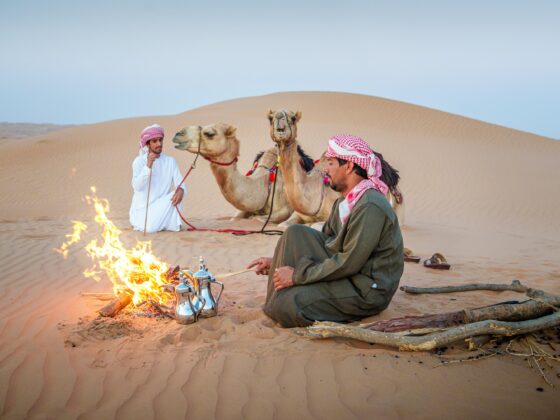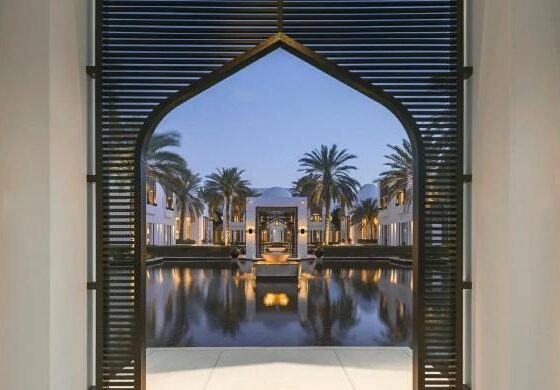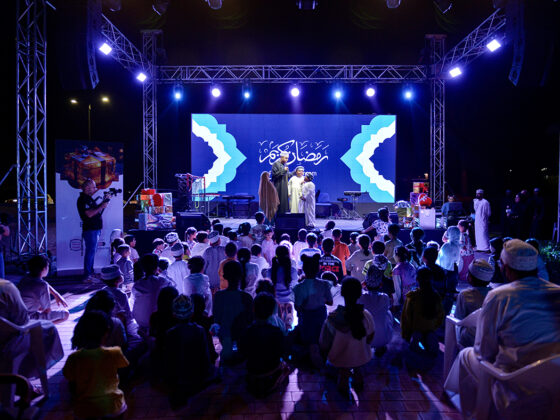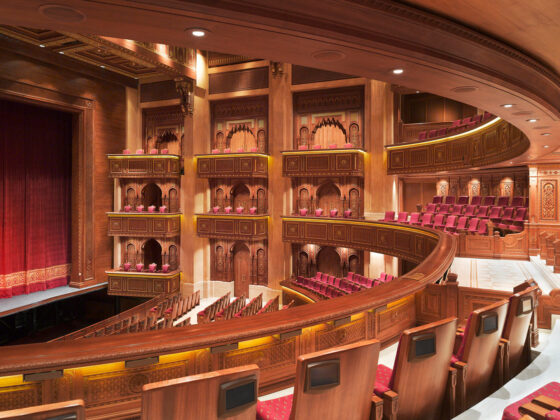by SALIM AL AFIFI
Monty Lewis’ body of work is a beautiful marriage of romance and history that blends ancient traditions with contemporary art, creating exotic-looking sporrans that inspire the mind and fascinate the wearer.
This fundamental and fashionable piece that complements the Scottish traditional ensemble is made of a wide variety of materials that bring out the best of leathers and goat pelts, which are quite the fashion statements.

For Monty, transforming these interesting material into cultural fashions has been a lifelong passion. His craftsmanship is beyond inspiring. For that very reason, I had to meet him for a quick chat about his beautifully made sporrans that were a highlight at the 2018 Scots in Oman Ball. And, we ended the session with spectacular photographs that showcase the beauty of Scotland’s national attire, styled with Middle Eastern details, and captured against the backdrop of beautiful Oman.
Salim: We had a lot of fun photographing the sporran in Qantab. What a lovely collection.
Monty: Thank you. When I heard that the Scots in Oman ball will take place in Oman, I began daydreaming about the beautiful landscape and thought it would be such a shame not to show off our kilts and sporrans to the Omanis, on their land.
S: What inspired your latest collection?
M: Romance is what inspires me overtime I make sporrans. The romance surrounding the object, the stories that are invoked and attach to them. And the materials truly set off my creativity; their tactile quality and beauty are just amazing. Then there is the manufacturing process; I am fascinated about how something is made. So I combine beautiful materials with interesting manufacturing processes.
One of my latest designs is the Nureyev sporran, inspired by the silver thread embroidery of an antique waistcoat. It was the beauty and detail of the hand embroidery that attracted me. I knew that if a highland chieftain of old had seen this embroidery they would have commissioned it somewhere in their clothing, just to outdo a neighbouring chieftain. It’s no different today, the Scottish men like to get one up on each other when it comes to highland dress.
S: How interesting. What triggered you to start designing sporrans?
M: It was all triggered when I attended a highland gathering at the age of eighteen. All the old Highland families had put aside their ancient feuds and would meet at this ball each year to socialise. They had however not put aside their sporrans! gentleman would arrive in full highland dress, with huge, exquisitely ornate sporrans as the centrepiece. A few of the young men would also, be wearing these heirlooms, their great, great, great grandfathers sporrans. They were incredibly crafted, the finest leatherwork coupled with faultless silver-smithing.
Sadly my great grandfathers’ sporran had long succumbed to the moth and unable to buy an antique sporran like those I’d seen. I decided to make my own.
From making this first sporran I found that it was a fantastic vehicle to use to combine different craftsmanship techniques, materials and my creativity. Where else could you combine fine leather-working with the detail of metal-working and materials as unique as buffalo horn?

S: How did you choose your materials for the collection, what influenced your selection?
M: I chose buffalo horn after visiting a factory in one of our national parks the Lake District, the factory had been working horn with the same processes since 1749. The thinly sliced and pressed buffalo horn had a similar appearance to tortious shell. It reminded me of an antique tortoise shell peineta comb worn by Spanish women in the 19th century, the intricately cut design inspired me to use the same process on the buffalo horn.
The idea of using shell came from a visit to India where I had seen patterns cut in mother of pearl shell for fringing. I thought, wow that would look incredible, why not scale it up to a huge shell, no one else has got that on a sporran.
The gold passementerie was inspired by some I’d seen in paintings of Highlanders from the 18th century. I wanted to bring in this traditional look with the other more outlandish materials.
The hairy part of the sporran is very important; it’s this that makes them look so unique, like relics of an ancient world. The oldest most traditional sporrans use highland goat hide, these are very hard to acquire today and most sporran makers import theirs from China. However, I wanted to keep my supply chain local to support as many industries in Scotland as possible, and to reduce the impact on the environment. So my sporrans are made of Highland cowhide, its such an icon beast around the world, synonymous with Scotland, it gives the product great provenance.

S: What were your favourite material used?
M: I love the metal thread embroidery. I think it is just such an exquisite material, I look at it and I can feel the hours of craftsmanship that go into making it. It is also cold to the touch, beautiful to all the senses.
S: The sporrans are such a strong part of the Scottish heritage. How do you, through your designs, keep this cultural heritage alive in this Millennial age?
M: Kilts have remained hugely popular with young people in Scotland. They enjoy wearing them as a celebration of Highland heritage. Formal evening wear such as Highland dress is not worn as much these days in Britain. However I think that with events becoming less formal men are open to wearing something more interesting than the commonplace black-tie, Highland dress gives them far more freedom to wear more interesting clothes. So I want to encourage a bit of flamboyance, which is exactly what sporrans are about. Currently, most of what you can buy is very boring and mostly made aboard, the style that I make is far more interesting and finely crafted.











